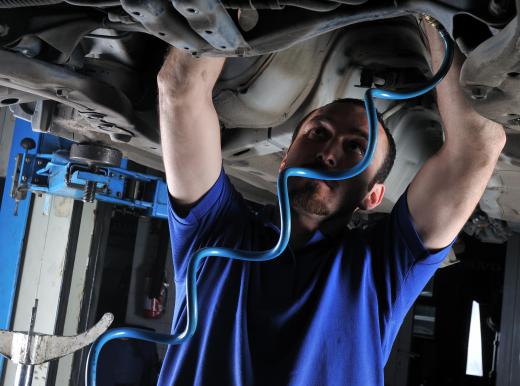A stud driver is a tool that is used to drive a metal fastener called a stud into another material. Studs can be thought of as similar to bolts, but they do not have heads. They may be fully threaded along their lengths, threaded on both ends but not in the middle, threaded on one end only, or completely unthreaded. The term stud driver may refer to the special socket designed to grip the stud only, or more generally to the entire assembly of the socket and the tool that powers its rotation, such as an impact wrench. Nail guns are sometimes referred to casually as stud drivers although this is not technically correct.
Sizes of stud driver tools range from simple hand tools to free-standing, industrial-sized machinery. Specially designed stud drivers may have features such as the ability to drive the stud to a specified depth — rather than flush with the receiving material — or torque control to drive the stud to a specified torque and no further. Some stud driver tools may be used to remove such fasteners in addition to installing them. Others are specially designed for use underwater or in other atypical environments.

Commercial uses for stud drivers may be very large scale such as in the manufacture and maintenance of automotive, locomotive, aircraft, and marine engines and components in residential or commercial construction. Smaller scale and more delicate applications include such uses as in the assembly of radio and computer components and in furniture manufacturing. Underwater stud drivers may be used, for example, in construction, maintenance, or modification of submerged or partially submerged concrete structures.
Stud drivers are most commonly pneumatically powered or powder-actuated. A pneumatically powered stud driver uses compressed air to drive the fastener into the receiving material. This necessitates the use of a bulky compressed air tank that may be inconvenient for the user. Powder-actuated means that tool is powered through controlled combustion of gunpowder in an enclosed chamber in the tool. Such high power automation makes it much easier and faster to drive studs through materials such as concrete.
Due to the high power and speed of a stud driver, safety precautions should be taken and extreme care exercised when it is in use. All safety and operating manuals and instructions should be read and understood prior to use of the tool. Appropriate eye, ear, head, and hand protection should be worn.
No part of the body should be in front of the muzzle when the tool is loaded. The stud driver should never be pointed in the direction of another person and should never be left unattended when loaded. Unnecessary bystanders should be removed from the area whenever possible to avoid injury or fatality in the event of an accidental ricochet of a stud. Formal training and certification classes may be available, especially for powder-actuated tools.
